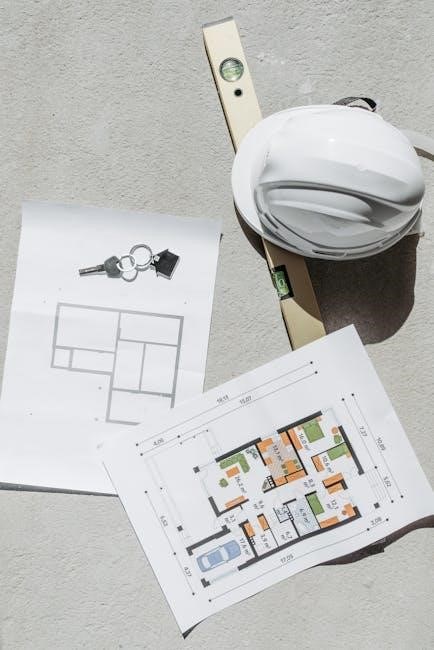AutoCAD shortcut keys are essential tools for enhancing efficiency and productivity in drafting and design workflows․ These keys streamline tasks, allowing users to focus on creativity and precision․
Overview of AutoCAD and the Importance of Shortcut Keys
AutoCAD is a powerful drafting and design software widely used in various industries․ Shortcut keys play a crucial role in enhancing productivity by allowing quick access to commands․ These keys simplify tasks, reduce time spent on repetitive actions, and improve workflow efficiency․ A comprehensive AutoCAD shortcut keys PDF guide provides users with an organized list of hotkeys, enabling them to master essential commands effortlessly․ This resource is indispensable for both beginners and professionals aiming to optimize their design processes and streamline project execution․

Basic AutoCAD Commands and Their Shortcuts
Mastering basic AutoCAD commands like L for LINE and C for CIRCLE enhances drafting efficiency․ These shortcuts are foundational for creating and modifying designs effectively in AutoCAD․
Top 50 Most Used AutoCAD Commands
The top 50 AutoCAD commands include essential tools like L (LINE), C (CIRCLE), and M (MOVE)․ These commands are frequently used for drawing and modifying objects efficiently․ Additionally, CO (COPY) and E (ERASE) are indispensable for duplicating and removing entities․ Other key commands include REC (RECTANGLE), A (ARC), and O (OFFSET), which simplify the creation of complex shapes․ Mastery of these commands significantly speeds up the design process, making them a cornerstone of AutoCAD proficiency for both beginners and experienced users alike․
Common Drawing Commands (L ⎯ LINE, C ⎯ CIRCLE, REC ‒ RECTANGLE)
L (LINE) creates straight lines, while C (CIRCLE) draws circles with a specified radius․ REC (RECTANGLE) generates rectangles with defined dimensions․ These commands are foundational for creating basic shapes in AutoCAD․ Using their shortcuts streamlines the drawing process, enabling quick creation of lines, circles, and rectangles․ They are essential for drafting precise geometries and are frequently used in architectural and engineering designs․ Mastery of these commands enhances efficiency in producing accurate and detailed drawings․
Modification Commands (M ⎯ MOVE, CO ⎯ COPY, E ⎯ ERASE)
M (MOVE) repositions objects, CO (COPY) duplicates them, and E (ERASE) removes unnecessary elements․ These commands are crucial for editing and refining designs․ Using their shortcuts saves time and ensures precise control over object manipulation․ They are indispensable for making adjustments and maintaining drawing accuracy․ Regular use of these commands helps in streamlining workflows and improving productivity in both 2D and 3D projects․ By mastering these tools, users can efficiently manage and modify their designs with ease and accuracy․
Benefits of Using AutoCAD Shortcut Keys
AutoCAD shortcut keys enhance efficiency, reduce errors, and save time․ They streamline workflows, allowing for faster task completion and improved design accuracy, boosting overall productivity significantly․
Improving Productivity and Efficiency
AutoCAD shortcut keys significantly boost productivity by reducing the time spent on repetitive tasks․ With shortcuts like L for Line and C for Circle, users can quickly access common commands, minimizing mouse navigation․ This efficiency allows for faster drafting and design, enabling professionals to meet deadlines more effectively․ Additionally, shortcuts reduce errors caused by manual input, ensuring accuracy in complex projects․ Mastery of these keys streamlines workflows, making the design process smoother and more efficient overall․
Streamlining Workflow in AutoCAD
AutoCAD shortcut keys play a crucial role in streamlining workflows by minimizing mouse navigation and reducing the time spent accessing commands․ Standardized shortcuts ensure consistency across projects, enhancing collaboration and efficiency․ For instance, using L for Line and C for Circle simplifies drawing tasks, while M for Move and CO for Copy accelerate modifications․ These shortcuts enable users to maintain focus on design and drafting, ensuring seamless execution of complex tasks․ A comprehensive PDF guide to AutoCAD shortcuts further aids in quick reference, optimizing workflow management․

Modifier Keys and Toggles in AutoCAD
Modifier keys like Ctrl, Alt, and Shift enhance command execution, while toggles such as F3 (Object Snap) and F8 (Ortho) streamline drafting workflows, improving efficiency and precision in design tasks․
Function of Modifier Keys (Ctrl, Alt, Shift)
Modifier keys such as Ctrl, Alt, and Shift play a crucial role in enhancing command execution in AutoCAD․ They allow users to access advanced features quickly, combining with other keys to perform complex actions․ For instance, Ctrl + S saves the drawing, while Shift + Spacebar cycles through overlapping objects․ These keys enable efficient navigation and task execution, making workflows smoother and more productive․ By mastering modifier keys, users can optimize their design process and achieve precise results efficiently․
Common Toggles (F3 ⎯ Object Snap, F8 ‒ Ortho)
F3 toggles Object Snap, enabling precise alignment with existing objects by snapping to key points like endpoints or midpoints․ F8 activates Ortho mode, restricting cursor movement to horizontal or vertical directions․ These toggles are fundamental for maintaining accuracy and control in drafting․ By using F3 and F8, users can ensure exact alignments and straight lines, streamlining the design process and reducing errors․ Mastering these toggles enhances workflow efficiency and precision in AutoCAD․
Selection Cycles and Their Shortcuts
Selection cycles in AutoCAD streamline object selection, especially when objects overlap․ Ctrl + Shift + Left/Right cycles through overlapping objects, while F7 toggles between wireframe and solid object selection․ These shortcuts enhance precision and speed by allowing users to quickly target specific objects without manually selecting them․ By mastering these tools, users can improve efficiency and reduce time spent on complex selection tasks in their workflows;

Dimensioning and Annotation Shortcuts
AutoCAD dimensioning shortcuts like D ‒ DIMSTYLE and T ⎯ TEXT simplify annotation tasks․ These tools enable quick creation of dimensions and text, enhancing precision and workflow efficiency․
Key Commands for Dimensioning (D ‒ DIMSTYLE)
The D ‒ DIMSTYLE command is essential for creating and managing dimension styles in AutoCAD․ It allows users to define settings for text, arrows, and fit options․ This shortcut ensures consistency across drawings․ Other key commands include DIMLINEAR for linear dimensions and DIMRADIUS for radius dimensions․ These tools streamline the annotation process, saving time and reducing errors․ By mastering these dimensioning shortcuts, users can enhance accuracy and efficiency in their workflows․ They are indispensable for precise and professional CAD designs․
Text and Annotation Shortcuts (T ‒ TEXT)
The T ‒ TEXT command allows users to add single-line or multi-line text annotations in AutoCAD․ It is crucial for labeling designs and providing detailed information․ Other shortcuts like MTEXT (multi-line text) and TED (text editor) enhance text manipulation․ These tools offer formatting options, alignment features, and quick access to styling․ By utilizing these shortcuts, users can efficiently annotate and communicate design intent․ They are vital for clear and professional documentation in CAD projects, ensuring clarity and precision in annotations․

3D Modeling and Navigation Shortcuts
3D modeling and navigation shortcuts like 3DORBIT and EXTRUDE simplify complex tasks․ These commands enable precise control over 3D objects and views, enhancing workflow efficiency and design accuracy․
3D Navigation Commands (3DORBIT ⎯ 3D Orbit)
3DORBIT is a key command for navigating 3D models, allowing users to rotate and view objects from any angle․ It enhances spatial understanding and design precision․ Other commands like EXTRUDE and LOFT simplify 3D modeling by creating complex shapes quickly․ These shortcuts streamline workflows, enabling efficient manipulation of 3D objects․ By mastering these commands, users can achieve precise control over their designs and improve overall productivity in AutoCAD․
3D Modeling Shortcuts (EXTRUDE, LOFT)
EXTRUDE and LOFT are essential shortcuts for creating complex 3D shapes in AutoCAD․ EXTRUDE transforms 2D profiles into 3D objects by adding depth, while LOFT connects multiple cross-sections to form intricate geometries․ These commands simplify the modeling process, enabling precise control over shape creation․ By mastering these shortcuts, users can efficiently construct detailed 3D designs, enhancing productivity and creativity in AutoCAD․ These tools are fundamental for architects and engineers aiming to craft accurate and visually appealing 3D models․

File Management and Exporting Shortcuts
AutoCAD offers shortcuts like QSAVE for quick saving and EPDF for exporting drawings to PDF, enhancing workflow efficiency and streamlining file management tasks․
Save and Close Commands (QSAVE, CLOSEALL)
QSAVE quickly saves the current drawing without prompting for a filename, ensuring work is protected․ CLOSEALL closes all open windows and files, helping to organize sessions and free resources․ These commands are vital for efficient file management, preventing data loss and streamlining workflows in AutoCAD․ By integrating these shortcuts, users maintain productivity and focus on design tasks without interruptions․ Regular use of QSAVE and CLOSEALL enhances overall efficiency, making them indispensable in daily drafting routines․
Exporting Drawings to PDF (EPDF)
The EPDF command allows users to export AutoCAD drawings directly to PDF format, ensuring high-quality output for sharing and printing․ This shortcut simplifies the process of converting files, maintaining vector quality and layout settings․ By using EPDF, users can quickly generate professional-grade documents without navigating complex menus․ This feature is particularly useful for presenting designs to clients or collaborators who require precise and readable files․ EPDF streamlines the export process, saving time and effort in workflows․ It is an essential tool for efficient document management in AutoCAD․

Customizing and Managing AutoCAD Shortcuts
Customizing AutoCAD shortcuts allows users to create personalized commands, enhancing workflow efficiency․ This feature enables users to manage and edit shortcuts, ensuring a tailored experience that boosts productivity․
Creating Custom Shortcuts
AutoCAD allows users to create custom shortcuts, enhancing their workflow․ By assigning specific commands to keys, users can streamline tasks and improve efficiency․ Access the Customize User Interface (CUI) to define new shortcuts․ Choose a command, select a key combination, and save changes․ This feature ensures a personalized experience, making it easier to access frequently used tools․ Custom shortcuts can also be exported and shared, providing consistency across teams․ This flexibility is a powerful tool for optimizing productivity in AutoCAD․
Managing and Editing Shortcut Keys
Managing and editing shortcut keys in AutoCAD is straightforward through the Customize User Interface (CUI)․ Users can modify existing shortcuts or create new ones․ The CUI allows assigning commands to specific key combinations, ensuring personalized efficiency․ Additionally, shortcuts can be exported and imported, facilitating uniformity across projects․ Regularly reviewing and updating shortcuts helps maintain optimal workflow․ This feature ensures that users can adapt AutoCAD to their specific needs, enhancing productivity and streamlining design processes․ Effective management of shortcuts is key to maximizing efficiency in AutoCAD․

Top 50 Most Used AutoCAD Commands
Mastering the top 50 AutoCAD commands enhances efficiency․ Essential commands include L (LINE), C (CIRCLE), REC (RECTANGLE), M (MOVE), CO (COPY), E (ERASE), O (OFFSET), and more․ These form the core of daily drafting tasks, streamlining workflows for designers and drafters․
Essential Commands for Everyday Use
AutoCAD’s essential commands form the foundation of efficient drafting․ L (LINE) draws straight lines, C (CIRCLE) creates circles, and REC (RECTANGLE) generates rectangles․ M (MOVE) repositions objects, while CO (COPY) duplicates them․ E (ERASE) removes unwanted elements, and O (OFFSET) creates parallel lines or curves․ These commands are indispensable for daily tasks, enabling quick execution of fundamental operations․ By mastering these, users can significantly boost their productivity and streamline workflows in AutoCAD․ They are the building blocks for more complex designs and modifications․
Advanced Commands for Complex Tasks
Advanced AutoCAD commands are crucial for tackling intricate designs and complex projects․ 3DORBIT enables 3D object manipulation, while EXTRUDE and LOFT create sophisticated 3D models․ ARRAY (AR) generates patterns, and 3DPOLY draws 3D polylines․ EXTERNALREFERENCES (ER) manages linked files, enhancing collaboration․ POLYGON (POL) creates complex shapes, and SPLINE (PLINE) handles curved designs․ These tools empower users to create detailed, precise models and manage large-scale projects efficiently, making them indispensable for advanced drafting and design workflows in AutoCAD․

Printing and Publishing Shortcuts
AutoCAD provides shortcuts like PLOT (Ctrl+P) and EPDF for efficient printing and publishing․ These tools streamline plotting and exporting processes, ensuring accurate and professional outputs․
Plotting and Publishing Commands
AutoCAD offers essential shortcuts for plotting and publishing, ensuring efficient output of drawings․ Key commands include PLOT (Ctrl+P) for initiating print setups and EPDF for exporting drawings directly to PDF format․ These tools simplify the process of configuring layouts, selecting print areas, and managing output settings․ Additional commands like publish and batchplot enable batch processing and publishing multiple sheets, streamlining workflows for large projects․ These shortcuts enhance productivity and accuracy when finalizing and sharing designs․
Configuring Layouts for Printing
Configuring layouts for printing in AutoCAD involves essential shortcuts to optimize output settings․ The PLOT command (Ctrl+P) initiates print setups, while EPDF exports drawings to PDF․ Other key shortcuts include PAGESETUP for defining page settings, LAYERSTATE to manage layer visibility, and CLOSEALL to close unnecessary windows․ These tools help users define print areas, set margins, and organize layers, ensuring precise and professional output․ Mastering these shortcuts streamlines the printing process, saving time and enhancing workflow efficiency․

Help and Resources for AutoCAD Shortcuts
Access the AutoCAD Shortcut Keys PDF for a comprehensive guide․ Use F1 for in-software help, and explore online forums for additional tips and resources to master shortcuts efficiently․
Accessing Help and Documentation
AutoCAD provides extensive help resources to master shortcut keys․ Press F1 to access the built-in help documentation, which includes detailed guides on all commands and shortcuts․ Additionally, users can download the official AutoCAD Shortcut Keys PDF from Autodesk’s website or third-party resources․ This PDF serves as a quick reference for essential commands, making it easier to learn and memorize shortcuts․ Online forums and tutorials also offer tips and tricks for optimizing workflow with keyboard shortcuts․ Utilize these resources to enhance your proficiency and streamline your design process effectively․
Downloading the AutoCAD Shortcut Keys PDF
The AutoCAD Shortcut Keys PDF is a valuable resource for users seeking to improve efficiency․ Available for download from Autodesk’s official website, it lists over 200 shortcuts and commands․ This guide organizes shortcuts into categories like drawing, modifying, and 3D modeling․ Printable versions are also offered, allowing users to create keyboard stickers․ The PDF is regularly updated to reflect new features and commands, ensuring users stay current with the latest tools․ Downloading this guide is a practical step toward mastering AutoCAD’s extensive shortcut library․
Mastering AutoCAD shortcut keys transforms your workflow, boosting efficiency and productivity; Regular practice and customization of these tools ensure optimal performance in drafting and design tasks․
Final Thoughts on Mastering AutoCAD Shortcuts
Mastering AutoCAD shortcuts significantly enhances your design and drafting efficiency․ Regular practice and customization ensure quick access to tools, streamlining your workflow and reducing errors․ By utilizing resources like the AutoCAD shortcuts PDF, you can stay updated with the latest commands, optimizing your productivity and creativity․ Embrace these tools to elevate your skills and deliver high-quality results consistently․ The investment in learning shortcuts pays off, making you a proficient and confident user of AutoCAD․

Leave a Reply